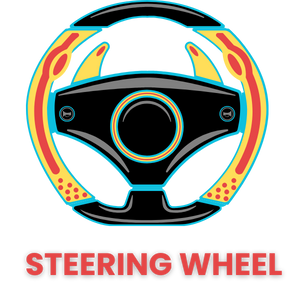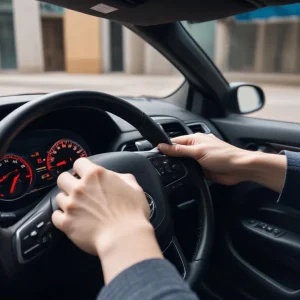Ever noticed your steering wheel shakes when braking? It’s not just an annoying fluke; it’s a sign that something’s incorrect with your car. Addressing this issue promptly is essential for your safety and the longevity of your vehicle.
In this blog post, we’ll explore why a shaking steering wheel is a concern, the main causes behind it, and how to diagnose and fix the problem.
Understanding the Basics: Why Does the Steering Wheel Shake When Braking?
How Braking Should Work
In a well-functioning braking system, pressing the brake pedal engages the brake pads, which then shut down on the rotors to slow your car. This process should be smooth and steady, allowing you to come to a stop without any vibrations or shaking.
Common Symptoms of Steering Wheel Shaking
When your steering wheel shakes while braking, it’s often accompanied by other symptoms:
- Vibrations in the Brake Pedal: You might feel a pulsating sensation in the brake pedal.
- Noise: Unusual sounds such as grinding or squeaking can accompany the shaking.
- Difficulty Controlling the Vehicle: The car may pull to one side, making it hard to steer.
Why Early Diagnosis is Crucial
Ignoring this problem can lead to serious consequences. Shaking can indicate underlying issues that compromise your vehicle’s ability to stop effectively, putting you and others at risk. Early diagnosis helps you address minor issues before they escalate into costly repairs.
Main Causes of Steering Wheel Shakes When Braking
Warped Brake Rotors
How Brake Rotors Work: Brake rotors are metal discs connected to each wheel. When you press the brake pedal, the brake pads squeeze the rotors to create friction, slowing the car down.
Causes of Warping: Rotors can warp due to excessive heat, wear and tear, or even improper installation. Over time, this warping can lead to uneven surfaces on the rotors, causing vibrations when the brake pads make contact.
Why Warped Rotors Cause Shaking: When rotors are not perfectly flat, the brake pads can’t grip them evenly. This uneven contact creates vibrations that travel up the steering column, causing the steering wheel to shake.
Worn Brake Pads
Brake Pads and Rotors Interaction: Brake pads are designed to wear down over time as they press against the rotors to create the friction needed to stop your car.
Signs of Worn Brake Pads:
- Squeaking or Squealing Noises: Often the first sign that your brake pads are wearing thin.
- Reduced Braking Performance: You may notice it takes longer to stop.
- Visible Wear: If you can see the brake pads through the wheel spokes, check for thinning.
Impact on Steering Wheel Stability: Worn brake pads can cause uneven pressure on the rotors, leading to shaking when you apply the brakes.
Dry Guide Pins
Role in the Braking System: Guide pins allow the brake calliper to move smoothly. They ensure that the brake pads make uniform contact with the rotors.
Effects of Dry or Corroded Guide Pins: Dry or rusted guide pins can cause the brake calliper to stick or not move freely, leading to uneven braking pressure and steering wheel vibrations.
Maintaining and Lubricating Guide Pins: Regularly lubricating the guide pins can prevent them from drying out and eroding, ensuring smooth braking action.
Unevenly Tightened Rotors
Importance of Correct Rotor Installation: Proper installation and even tightening of rotors are crucial for their smooth operation. Unevenly tightened rotors can cause wobbling and vibrations.
Symptoms of Uneven Rotor Tightening:
- Vibrations When Braking: The most obvious sign.
- Unequal Brake Pad Wear: One pad may wear faster than the other.
- Noisy Brakes: You might hear clicking or clunking sounds.
Ensuring Proper Installation: Always use a torque wrench to tighten rotors evenly to the manufacturer’s specifications. This helps in preventing uneven pressure and the resulting vibrations.
Suspension Issues
Overview of Suspension Components Affecting Braking: Your car’s suspension system includes various components like struts, shocks, and control arms, all of which affect braking performance.
Common Suspension Problems Causing Vibrations:
- Worn Out Shocks or Struts: Can’t absorb road impacts, leading to vibrations.
- Loose or Damaged Control Arms: Affect wheel alignment and braking stability.
- Worn Bushings: Increase the play in suspension parts, causing shaking.
Diagnosing and Fixing Suspension Issues: Regularly inspect your suspension components and replace worn parts to maintain a smooth, vibration-free ride.
Wheel Misalignment
How Wheel Alignment Affects Vehicle Handling: Proper wheel alignment ensures that your tyres meet the road at the correct angle and with even pressure, providing stability and control.
Signs of Misalignment:
- Uneven Tyre Wear: One side of the tyre wears faster.
- Pulling to One Side: The car drifts to the left or right.
- Steering Wheel Off-Center: The steering wheel isn’t straight when driving straight.
Importance of Regular Wheel Alignment Checks: Regular alignment checks can prevent uneven tyre wear and ensure smoother braking, reducing the risk of steering wheel shaking.
| More to Explore for You Interest: You Might Also Enjoy to Read | |
| 1 | Steering Wheel Shakes When Driving: 5Amazing Causes & Fixes |
| 2 | How to unlock steering wheel without key: 5 Proven Ways |
| 3 | Subaru Steering Wheel Locked: Wonderful Truth of 2024 Revealed Now |
Diagnosing the Problem: Steps and Tools
Visual Inspection of Brakes and Suspension
Conducting a Preliminary Visual Check: Start by visually inspecting your brake components and suspension system. Look for obvious signs of wear or damage.
Key Signs to Look For:
- Warped or Rusted Rotors: Visible distortions or rust.
- Thin Brake Pads: Less than a quarter-inch thickness.
- Leaking Shocks or Struts: Fluid leaks around the suspension.
Using Diagnostic Tools
Brake Gauges: Brake gauges help measure the thickness of your brake pads and rotors. Using these tools can confirm whether your components are within the manufacturer’s specifications or need replacing.
- How to Use: Place the gauge on the brake pad or rotor to measure its thickness.
- Interpreting Results: Compare the readings with the manufacturer’s recommended limits to determine if replacement is necessary.
Dial Indicators: Dial indicators measure the runout of your brake rotors and wheels. Excessive runouts can indicate warped rotors or misaligned components.
- How to Use: Attach the dial indicator to a fixed point near the rotor and rotate the rotor slowly to measure deviations.
- Signs of Excessive Runout: More than 0.002 inches can cause vibrations and should be addressed.
OBD-II Scanners: An OBD-II scanner can read error codes from your vehicle’s computer system, providing insights into potential problems affecting your braking system.
- How to Use: Plug the scanner into your vehicle’s OBD-II port and follow the instructions to retrieve error codes.
- Understanding the Codes: Use the scanner’s Manual or an online resource to decode the error messages and take appropriate action.
Professional Inspection and Repair
When to Seek Professional Help: Even with the appropriate tools and a keen eye for detail, it can sometimes be challenging to pinpoint the exact cause of steering wheel vibrations. If you’ve conducted a thorough visual inspection and used diagnostic tools without finding clear answers, it’s time to seek professional assistance.
What to Expect During a Professional Inspection: A qualified mechanic will perform a comprehensive examination of your vehicle’s braking system, suspension, and wheel alignment. They will use advanced diagnostic equipment to uncover issues that might not be visible during a general inspection. Additionally, mechanics can perform road tests to experience firsthand the vibrations and assess their potential causes.
Common Repairs for Resolving Vibrations:
- Resurfacing or Replacing Rotors: If warped rotors are identified, they may need to be resurfaced or replaced.
- Replacing Brake Pads: Worn or uneven brake pads will typically be replaced to ensure uniform contact with the rotors.
- Lubricating or Replacing Guide Pins: Ensuring smooth brake calliper movement by lubricating or replacing dry or corroded guide pins.
- Correcting Wheel Alignment: Realigning wheels to the manufacturer’s specifications to prevent uneven tyre wear and ensure stable braking.
- Suspension Repairs: Addressing worn shocks, struts, bushings, or control arms to maintain the integrity of your vehicle’s suspension.
Preventive Maintenance Tips
Regular Brake Inspections and Maintenance Schedules
Inspect your brakes every 10,000 miles or as recommended by your vehicle manufacturer. Replace brake pads and rotors as needed to prevent uneven wear and vibrations.
Choosing Quality Brake Components
Invest in high-quality brake pads, rotors, and callipers to ensure optimal performance and longevity. Avoid cheap, low-quality parts that can wear out quickly and cause issues.
Driving Habits That Reduce Wear and Tear
Avoid aggressive braking and sudden stops, which can put excessive stress on your brake components. Maintain a safe following distance to give yourself ample time to brake smoothly.
Rotating and Balancing Tires
Rotate your tires every 5,000 to 7,500 miles to ensure even wear. Balance your tires regularly to prevent vibrations and shaking while driving.
Checking and Maintaining Suspension Components
Regularly inspect your suspension system for any signs of wear or damage. Replace worn shocks, struts, and bushings promptly to avoid compromising your vehicle’s handling and ride quality.
Fixing the Issue – DIY Solutions and Professional Repairs
Replacing Warped Rotors
Materials and Tools Needed:
- New brake rotors
- Jack and Jack stands.
- Lug wrench
- Socket set
- C-clamp
- Brake cleaner
Step-by-Step Guide to Replacing Rotors:
- Lift your car and remove the wheel.
- Remove the brake calliper and the old rotor.
- Clean the area with brake cleaner.
- Install the new rotor and reassemble the brake components.
- Reattach the wheel and lower the car.
When to Consider Professional Resurfacing:
- If you lack the necessary tools or expertise.
- If the rotors are severely damaged.
Installing New Brake Pads
Detailed Instructions for Brake Pad Replacement:
- Lift your car and remove the wheel.
- Remove the brake caliper and old brake pads.
- Clean the area with brake cleaner.
- Install new brake pads and reassemble the brake components.
- Reattach the wheel and lower the car.
Tips for Selecting High-Quality Brake Pads:
- Choose pads made from durable materials like ceramic or semi-metallic compounds.
- Consider brands known for their quality and performance.
Lubricating Guide Pins
Importance of Proper Lubrication:
- Ensures even brake pad wear.
- Prevents noise and vibrations.
Steps to Lubricate Guide Pins Effectively:
- Lift your car and remove the wheel.
- Remove the brake caliper.
- Clean and lubricate the guide pins with high-temperature brake grease.
- Reassemble the brake components, reattach the wheel, and lower the car.
Ensuring Proper Wheel Alignment
How to Check and Adjust Wheel Alignment:
- Inspect tire wear patterns.
- Use an alignment tool or take your car to a professional service.
Benefits of Professional Alignment Services:
- Ensures precise adjustments.
- Can diagnose other potential issues.
Addressing Suspension Issues
Identifying and Replacing Faulty Suspension Components:
- Inspect shocks, struts, and control arms for wear and damage.
- Replace any worn-out parts.
When to Seek Professional Repairs:
- If you’re unsure how to diagnose suspension problems.
- For complex repairs requiring specialized tools.
When to Consult a Mechanic
While minor issues can often be diagnosed and fixed at home, some problems require a professional’s expertise. If you experience severe shaking, hear unusual noises, or notice reduced braking performance, it’s time to consult a mechanic.
What to Expect During a Professional Inspection: A professional inspection might involve:
- Comprehensive Brake System Check: This includes examining the rotors, pads, calipers, and brake fluid.
- Suspension Analysis: Checking struts, shocks, and bushings for wear and damage.
- Alignment Services: Ensuring the wheels are properly aligned.
Cost Considerations: Although professional repairs can be costly, addressing the issue early often saves money in the long run by preventing more serious damage.
Conclusion
A shaking steering wheel when braking is more than just an inconvenience; it’s a sign that something needs attention in your vehicle. Understanding the common causes, such as warped rotors, uneven tire wear, or suspension issues, and knowing how to diagnose and fix them can ensure a safer, smoother driving experience. Whether you choose to tackle the issues yourself or seek professional assistance, addressing these warning signs promptly is crucial to keeping your car in top shape.
To stay updated with the latest automotive tips and advice, subscribe to our blog and share this post with other car enthusiasts. Together, we can keep our vehicles running smoothly and safely.
Additional Resources
- Owner’s Manual: This product does not have an owner’s Manual.
- Service Centers: Visit authorized service centers for professional inspections and repairs.
- Official Website: For more information and resources, visit our official website.
- Social Media: Follow us on Facebook, Instagram, and X for the latest updates and tips.
Frequently Asked Questions
When it comes to steering wheel shaking and braking issues, many car owners have similar questions. Here are some of the most common ones:
Why is my steering wheel shaking when I brake at high speeds?
Steering wheel shaking at high speeds can be caused by several factors, including:
- Warped Rotors: Over time, brake rotors can become uneven due to excessive heat and wear. This uneven surface can cause the brake pads to grab inconsistently, resulting in a shaking sensation.
- Uneven Tire Wear: Tires that are worn unevenly can cause vibrations, especially when braking. This can be due to misalignment, improper tire pressure, or suspension issues.
- Suspension Issues: Worn or damaged suspension components such as ball joints, tie rods, and control arm bushings can lead to instability and shaking when braking.
It’s important to diagnose the problem and address it promptly to ensure your safety on the road.
How do you fix shaking when braking?
Fixing shaking when braking involves identifying the root cause and addressing it. Common solutions include:
- Replacing Warped Rotors: If the rotors are warped, they need to be either resurfaced or replaced.
- Installing New Brake Pads: Worn or damaged brake pads should be replaced to ensure even contact with the rotors.
- Ensuring Proper Wheel Alignment: Misaligned wheels can cause uneven tire wear, leading to vibrations. Proper alignment is crucial for a smooth ride.
- Lubricating Guide Pins: Brake caliper guide pins need to be properly lubricated to ensure smooth movement. Sticking guide pins can cause uneven braking force.
- Addressing Suspension Issues: Any worn or damaged suspension components should be repaired or replaced.
Is it safe to drive with a shaking steering wheel?
Driving with a shaking steering wheel is not safe. It can indicate underlying issues with your brake system, tires, or suspension that need to be addressed. Ignoring the problem can lead to:
- Further Damage: Continuing to drive with a shaking steering wheel can cause more extensive damage to your vehicle’s brake system, tires, and suspension.
- Compromised Safety: A shaking steering wheel can reduce your control over the vehicle, increasing the risk of accidents. It’s crucial to have the issue diagnosed and repaired promptly.
Can bad alignment cause vibration when braking?
Yes, bad alignment can cause vibrations when braking. Misaligned wheels can lead to uneven tire wear, which in turn can cause steering wheel shaking. It’s important to regularly check and adjust wheel alignment to prevent this issue.
What is the most common cause of steering wheel shaking?
The most common cause of steering wheel shaking is warped brake rotors. When rotors become uneven, they can create vibrations felt through the steering wheel, especially when braking at high speeds. Other potential causes include:
- Uneven Tire Wear: As mentioned, misalignment or improper tire pressure can cause uneven wear, leading to vibrations.
- Suspension Issues: Worn or damaged components can affect vehicle stability and cause shaking.
- Brake Pad Issues: Worn or damaged brake pads can create an uneven braking force, leading to vibrations.
Regular maintenance and prompt attention to any signs of shaking can help ensure your vehicle remains safe and comfortable to drive.








Leave a Reply